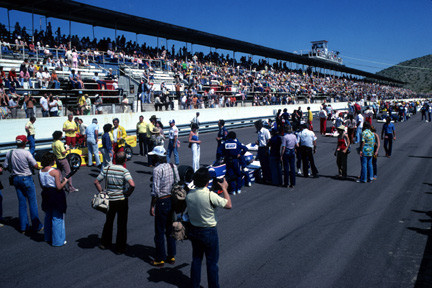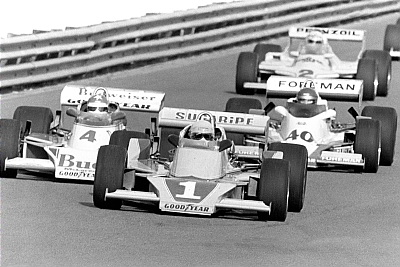The Way It Is/ What have we learned?
by Gordon Kirby Thirty years ago this past weekend CART ran its first race at the one-mile Phoenix Int'l Raceway. Twenty-one cars took the green flag and Gordon Johnock came through to win for Pat Patrick's team after polewinner Bobby Unser ran into trouble with his brand new Penske PC7. Driving one of the previous year's PC6s for Patrick's team run by master mechanic George Bignotti, Johncock beat Rick Mears in another PC6, Tom Sneva's McLaren M24 and Al Unser's Lola T500. Bobby Unser made it home a lap down in fifth place ahead of Mike Mosley's Eagle and Wally Dallenbach's Wildcat. It was the start of an exciting new era in American motor sport that ultimately unraveled a quarter of a century later amid a sad display of the worst human failings.
Thirty years ago this past weekend CART ran its first race at the one-mile Phoenix Int'l Raceway. Twenty-one cars took the green flag and Gordon Johnock came through to win for Pat Patrick's team after polewinner Bobby Unser ran into trouble with his brand new Penske PC7. Driving one of the previous year's PC6s for Patrick's team run by master mechanic George Bignotti, Johncock beat Rick Mears in another PC6, Tom Sneva's McLaren M24 and Al Unser's Lola T500. Bobby Unser made it home a lap down in fifth place ahead of Mike Mosley's Eagle and Wally Dallenbach's Wildcat. It was the start of an exciting new era in American motor sport that ultimately unraveled a quarter of a century later amid a sad display of the worst human failings.
CART (Championship Auto Racing Teams) was formed in the fall of 1978 by USAC team owners Roger Penske, Pat Patrick, Dan Gurney, A.J. Foyt, Jim Hall, Teddy Mayer and Tyler Alexander for McLaren, plus Bob Fletcher and Jerry O'Connell. The team owners originally intended to act as a collective bargaining group to pressure the United States Auto Club and the race promoters to raise the level of prize money, TV coverage and commercial sponsorship as well as taking a more pragmatic and knowledgeable view of Indy car racing's technical and engine rules.
But by the time winter arrived the team owners had decided they couldn't work with USAC and would run their own series in 1979. Back then, prize money averaged between only $80,000-$100,000 for most races and the Indy 500 paid a grand total of just $1.2 million with $300,000 going to the winner. Other than Indy, TV coverage was nonexistent, nor was there a series sponsor to help promote and market the sport. CART aimed to change all that and also bring some stability to the engine and car rules to help make a very expensive sport more cost-effective.
Yet right from the beginning the owners tended to squabble among themselves. A few months before the '79 season began Foyt deserted CART and rejoined USAC, becoming a persistent critic of CART. A.J. won five of USAC's seven races in '79, breezing to the last of his record seven USAC titles. It was also USAC's last season of sanctioning Indy car races as the two organizations briefly formed a combined Championship Racing League in 1980. But the CRL partnership fell apart before the year was out and CART took off entirely on its own with USAC continuing strictly as the sanctioning body for the Indy 500.

© Paul Webb
These were very different times of course when many teams built their own cars or engines and when we were fresh from the Penske and Parnelli teams competing in F1 for a few years and Mario Andretti was the defending F1 World Champion with Team Lotus. Back then, American race teams were respected around the world and despite the problems the USAC Championship encountered through the seventies we had a great roster of Indy car stars--Foyt, Andretti, the Unser brothers, Johnny Rutherford, Gordon Johncock, Tom Sneva and Danny Ongais among them.
Bobby Unser qualified his brand new Penske PC7 on the pole for CART's first race ahead of Sneva's Sugaripe Prune McLaren (owned by Jerry O'Connell), Rutherford's factory McLaren, Ongais's Interscope Parnelli and Rick Mears in a Penske PC6. Unser dominated the early laps with the new ground-effect PC7 but his car's handling deteriorated and he fell back. Ongais took the lead only to blow an engine, allowing Johncock to forge ahead and collect $18,670 for winning the race.
On the track the '79 season belonged to Mears who won the first of his four Indy 500s and two CART races to take the inaugural CART championship in his second of fifteen years with Penske Racing. Teammate Bobby Unser won six races but failed to finish too many times and was beaten to the title on consistency, a Mears trademark. Johncock finished third in the championship ahead of Rutherford and Al Unser.
Looking back, it wasn't much of a series with small to middling crowds, few, if any, high-profile venues and not much depth in teams, but it was better than USAC's rival seven-race championship. In 1980, Mears twice tested a Brabham F1 car and was offered a ride by Bernie Ecclestone who then owned the Brabham team. Mears was interested in the money and prestige of racing in F1 but he was also wary of Indy car racing's future.
"My thinking at the time was I might pursue this a little bit, just to keep my foot in the door in case CART didn't make it," Rick says in my book 'Rick Mears-Thanks'. "The money in F1 was good, yes, but it was road courses only and I liked ovals. I could see CART getting strong and I like the variety of CART with short ovals, long ovals, street circuits and permanent road courses. I felt like you had to be a more well-rounded driver to win the CART championship. To me, CART was more competitive and more challenging."
Thirty years later it's breathtaking to reflect that for a brief period of time CART was a rival, in various ways, to Formula 1. In 1980 PPG Industries signed on as CART's series sponsor and through the eighties and into the nineties the CART/PPG Indy Car World Series thrived, gathering a strong schedule of races and deep field of teams and increasingly international drivers. In fact, by the late eighties the only members of the original CART group to continue in the Indy car business were Penske, Patrick and Foyt.
Teddy Mayer and Tyler Alexander--Americans both--decided that McLaren would quit CART after the '79 season to concentrate on Formula 1. Jim Hall raced his Chaparral 2K for a few years with Johnny Rutherford but didn't race in CART between 1984-'90 although he would return for five years in the nineties with John Andretti and Gil de Ferran. Both Bob Fletcher and Jerry O'Connell lasted only a few years as Indy car owners while in the mid-eighties CART's rulemakers outlawed All American Racers' unique BLAT (Boundary Layer Adhesion Technology) Eagle and its highly-developed all-aluminum Chevy engine. The move led a few years later to the demise of Dan Gurney's legendary Indy car team, although AAR would return for a last hurrah in company with Toyota between 1994-'99.
Meanwhile new teams arrived like Newman/Haas, TrueSports, Doug Shierson and the Kraco team run by Barry Green for a young Michael Andretti. But few of these were able to develop into successful, longterm entities and the turnover in teams and owners added to CART's continual political squabbling and instability. CART was run in its first year by Jim Melvin, a former SCCA administrator who had worked for Penske at the Michigan Speedway. Melvin was replaced the following year by John Frasco, a lawyer who worked for Penske and Patrick and was responsible for getting the CART teams reinstated in the 1979 Indy 500 after USAC barred them from competing.

© LAT USA
Englishman Craig set the stage for the organization's financial failure when he followed Pat Patrick's instructions to float CART as a publicly-traded company on the New York Stock Exchange. Sadly, the influx of money served only to exacerbate the self-interest, egos and greed which had always been at the heart of CART's problems and in the end most of the team owners wound up selling their shares at a handsome profit and jumping ship. It was an abysmal display of everything the organization theoretically had been founded to prevent.
As we all know over the same thirty-year stretch of time F1 and NASCAR have elevated themselves to stratospheric heights from operating at roughly the same level as Indy car racing. Today both F1 and NASCAR face many serious problems but they are big problems resulting from thirty years of steady growth. It's hard to imagine Indy car racing coping with the difficulties of trying to maintain a 43-car field or a solid, multi-tiered ladder system like NASCAR enjoys, or like F1 keeping no fewer than five major manufacturers committed to the sport at an extremely high level, particularly after the shock of losing Honda.
Last week the Formula One Teams Association (FOTA) announced solidarity among themselves and with the FIA's efforts to reduce costs and improve the show. The manufacturers and teams are clearly beginning to assert their newfound political muscle and all ten of FOTA's team principals signed on to working with the FIA to implement a detailed package of changes over the next two years. If F1 proves capable of retaining its brace of manufacturers over the tough years of economic downturn it will emerge stronger than ever and last week's FOTA announcement indicates that, despite its infernal politics, F1's success story is likely to continue.
In contrast, without brands like Ferrari, Mercedes-Benz, BMW and Toyota, the IRL hopes that one of the new Porsche/Volkswagen group's brands--most likely VW--will decide to compete in its new two-liter turbo formula in 2012, thus providing Honda with the necessary competition to remain committed to Indy car racing. There are even hopes for a third manufacturer, specifically Fiat through its new alliance with Chrysler. We'll see.
Meanwhile, you may have noticed that the 30th anniversary of CART's birth passed with nary a ripple across the USA, let alone the global media. CART lasted just twenty-five years and its ignorant stepchild, Champ Car, survived only four more years before imploding for much the same reasons.
Today, America's media and the general public have no knowledge or interest in Indy car racing's incredible 100-year history. CART is irrelevant, USAC and the AAA forgotten. Despite their many ills, Formula 1 rules globally and NASCAR dominates domestically.
Auto Racing ~ Gordon Kirby
Copyright 2009 ~ All Rights Reserved
Copyright 2009 ~ All Rights Reserved
Top of Page